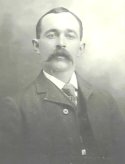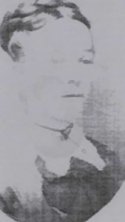| WILLIAM GLIENKE |
|
The broad prairies of Iowa have furnished splendid opportunities to the agriculturist. The soil is naturally rich and productive and nature has been kind in the matter of rainfalls and in other conditions which lead to successful agricultural activity. William Glienke is now classed with the representative farmers of Washington township, Chickasaw County, making his home on section 6. He was born in Germany, April 5, 1850, a son of Ernest and Kathleen (Ingnow) Glienke, who came to the United States in 1872. After residing for a year in Chicago they took their abode upon a farm in Cook county, Illinois, near that city, and there the father passed away in 1879. William Glienke, was reared and educated in his native country, being 22 years of age at the time of emigration of the family to the new world. In 1878 he married Albertina Schultz and in 1880 with his wife and one child, together with two brothers and his mother, he removed to Chickasaw County. Here he purchased 33 acres of his present home and his two brothers also made investments in farm lands, the mother making her home with her son Henry Glienke. As the years have passed William Glienke has prospered in his undertakings and, adding to his original farm, is now the owner of 160 acres of Chickasaw county's most fertile land. In 1881 Mr. Glienke was called upon to mourn the loss of his wife, who passed away in Chickasaw County, leaving two children: Anna, now the wife of Michael Erion, of Howard County, Iowa and Emma, who is the wife of William Vick, a farmer of Washington township, Chickasaw County. In 1884, Mr. Glienke, was again married, his second union being with Miss Alvina Peach. They have five living children: Minnie, the wife of Fred Semm, of Alta Vista; and Louis, Alfred, Herman and Arthur all at home. Mr. Glienke has become a stockholder in the Farmers Creamery Association of Alta Vista and in the Farmers Cooperative Lumber and Coal Company and the Farmers Cooperative Telephone Company. All three corporation are business concerns of Alta Vista. In becoming connected therewith Mr. Glienke has recognized the trend of modern business toward cooperation and has utilized his opportunities for aiding in the promotion of important interests. He is a member of the Lutheran church, and the sterling worth of his character is attested by those who have had business or social relations with him. Ref: History of Chickasaw and Howard Counties, Iowa, Vol. 2, Pages 504 and 505. Transcribed by Lookup Person, Leonard Granger |
| EBENEZER GRANGER |
Ebenezer A Granger, was born, 2 November, 1834 in the province of Ontario, Canada, a son of Abial C. and Melissa (Gleason) Granger. When he was seven years old, the family arrived in DeKalb Co, Illinois. The mother and youngest daughter died in 1842 from a milk sickness . Ebenezer worked on the family farm and there he received a common school education, and passed his youth. On 22 Feb 1856, he married Olive Marsh in DeKalb Co. Illinois. She was born in the state of New York and traveled to Illinois with her parents as a young child. Prior to their marriage, in the fall of 1855, Mr. Granger came to Iowa and located in Bremer County. He then returned to DeKalb county for his wife and in the spring of 1866 brought his bride to the pioneer home in Iowa which he established. Family members of the Granger and Marsh families made the overland trip together to Bremer County, Iowa and have separate listings in the 1919 History. In subsequent years he increased his holdings to 320 acres and resided upon the farm until 1888, when he rented the farm to a son, Lester A Granger, and moved to Nashua, Chickasaw County, Iowa. Here he became the president of the Nashua Water Power Company and was a dominant factor in the management of the corporation, continuing in that capacity until his death, which occurred in October, 1907, when he was in his 74th year. His widow survived him until June 1917, passing away at the age of seventy-six years. Source: History of Chickasaw and Howard Co (1919), Vol II, Page 469, (Parent of W. A. Granger and Lester A Granger in listings) |
| LESTER A. GRANGER |
Lester Allen GRANGER, (picture insert) has owned and
occupied a farm on Section 27, Chickasaw Township, Chickasaw County, and he
is further known as representative business man of his community
successfully engaged in selling commercial automobiles and trucks from his
Nashua headquarters. Lester was born in Bremer County, Iowa, April 2,
1872 and is a son of Ebenezer A. and Olive (MARSH)
GRANGER. April 2,
1872 and is a son of Ebenezer A. and Olive (MARSH)
GRANGER.Ebenezer A. GRANGER was born Nov 2, 1834 in Vermont and Olive (MARSH) GRANGER (picture insert) was born, March 10, 1838 in New York. They were married in Dekalb County, Illinois and in 1856 he brought his bride to Bremer County Iowa, and then they moved to Nashua, Chickasaw County in 1888. He became president of the Nashua Water Power Company.  Ebenezer
died Oct 5, 1907 and Olive died Aug 26, 1917; both are buried in Greenwood
Cemetery, Nashua. Of the four children born to Ebenezer & Olive
GRANGER, three sons, William, Adolphus, and Lester now live in Chickasaw
County, while daughter Ellia resides in Washington. Ebenezer
died Oct 5, 1907 and Olive died Aug 26, 1917; both are buried in Greenwood
Cemetery, Nashua. Of the four children born to Ebenezer & Olive
GRANGER, three sons, William, Adolphus, and Lester now live in Chickasaw
County, while daughter Ellia resides in Washington.Lester GRANGER was married on March 16, 1892 to Miss Carrie DANA, a daughter of Osman DANA and Mary Ann SUTHERLAND. They now have seven living children: Mrs W.B. HAMMOND; Mrs C.H. ISLEY; Hazel, who is a teacher in Nashua High School; Florence and Ebenezer, who are high school students; Willard and Harold, pupils in the grade schools. Willard GRANGER is a partner in Granger and Putney, dealers in lumber, coal and grain in Nashua. He married on Nov 28, 1879 Miss Mary M. NAFUS, daughter of A.H. NAFUS. They have two daughters Mrs Ethel STALEY and Mildred. His first wife died June 9, 1912 and on May 3, 1917 he married Mrs Mary (WEST) DODD, daughter of Frank WEST an early pioneer of Chickasaw County. Adolphus P. GRANGER married Miss Vera YOUNG and they farmed in Chickasaw County. He died April 16, 1921 and is buried in Greenwood Cemetery, Nashua. Source: History of Chickasaw and Howard Co (1919), Vol II, Synopsis of pages 454 - 465 |